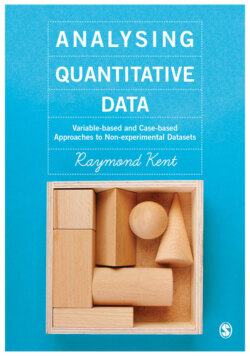Читать книгу Analysing Quantitative Data - Raymond A Kent - Страница 22
На сайте Литреса книга снята с продажи.
Box 1.1 The interpretation of Cronbach’s coefficient alpha
ОглавлениеAlpha has effectively become the measure of choice for establishing the reliability of multi-item scales. Its availability at the click of a mouse button in survey analysis programs like SPSS has almost certainly meant that it is commonly reported by researchers, but often with little understanding of what it means and what its limitations are.
Despite its wide use, there is little guidance in the literature (and none from Cronbach himself) as to what constitutes an ‘acceptable’ or ‘sufficient’ value for alpha to achieve. Most users of the statistic cite Nunnally’s (1978) recommendation that a value of 0.7 should be achieved. The coefficient is then treated as a kind of ‘test’; if alpha for any scale is greater than 0.7 then it is deemed to be sufficiently reliable. However, all those authors making recommendations about acceptable levels of alpha, including Nunnally, indicate that the desired degree of reliability is a function of the purpose of the research, for example whether it is exploratory or applied. Nunnally himself in 1978 suggested that for preliminary research ‘reliabilities of 0.70 or higher will suffice’. For ‘basic’ research, he suggests that ‘increasing reliabilities much beyond 0.80 is often wasteful of time and funds’ (Nunnally, 1978: 245). In contrast, for applied research, 0.80 ‘is not nearly high enough’. Where important decisions depend on the outcome of the measurement process a reliability of 0.90 ‘is the minimum that should be tolerated’.
None of Nunnally’s recommendations, however, have an empirical basis, a theoretical justification or an analytical rationale. Rather they seem to reflect either experience or intuition. Interestingly, Nunnally had changed his own recommendations from his 1967 edition of Psychometric Theory, which recommended that the minimally acceptable reliability for preliminary research should be in the range of 0.5 to 0.6.
Peterson (1994) reports the results of a study to ascertain the values of alpha actually obtained in articles and papers based on empirical work. From a sample of over 800 marketing and psychology-related journals, conference proceedings and some unpublished manuscripts, he reviewed all alpha coefficients found in each study, resulting in 4,286 coefficients covering a 33-year period. Reported coefficients ranged from 0.6 to 0.99 with a mean of 0.77. About 75 per cent were 0.7 or greater and 50 per cent were 0.8 or greater. Peterson found that reported alphas were not greatly affected by research design characteristics, such as sample size, type of sample, number of scale categories, type of scale, mode of administration or type of research. One exception to this is that during scale development items are often eliminated if their presence restricts the value of alpha. Not surprisingly, the alpha coefficients reported were significantly related to the number of items eliminated.
It is important to remember that alpha measures only internal consistency; if error factors associated with the passage of time are of concern to the researcher, then it will not be the most appropriate statistic. However, since alpha approximates the mean of all possible split-half reliabilities, it can be seen as a superior measure of scale equivalence. It is not, however, as is commonly supposed, an indication of unidimensionality. Alpha can, in fact, be quite high despite the presence of several different dimensions (Cortina, 1993).
When interpreting alpha coefficients, it is often forgotten, furthermore, that the values achieved are in part a function of the number of items. Thus for a three-item scale with an alpha of 0.80, the average inter-item correlation is 0.57. For a ten-item scale with an alpha of 0.80 it is only 0.28. What needs to be kept in mind is that in evaluating, say, a 40-item scale, alpha will be relatively large simply because of the number of items, and the number of items is not exactly a great measure of scale quality. When many items are pooled, internal consistency estimates are inevitably large and invariant, and therefore of limited value.
Alpha, in short, should be used with some caution. It is appropriate only when the researcher requires a measure of internal consistency, and is helpful only then if the number of items used is fairly limited. The value of alpha to be taken as ‘acceptable’ must be related to the purpose of the research, and even then only used as an indication rather than a ‘test’ to be passed with a fixed value. Furthermore, if researchers are concerned about dimensionality, then procedures like factor analysis are probably more appropriate. For a more recent review of Cronbach’s alpha see Lee and Hooley (2005).
